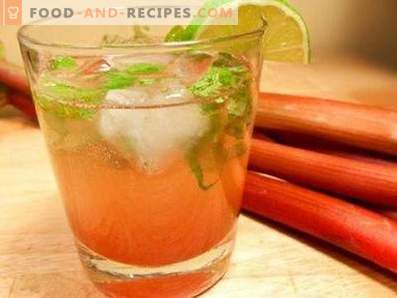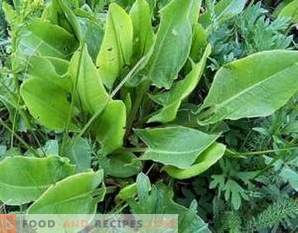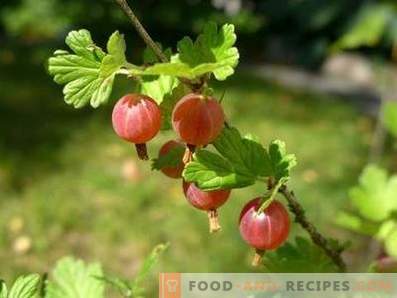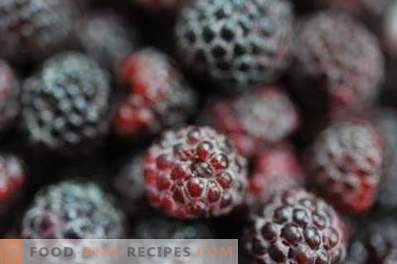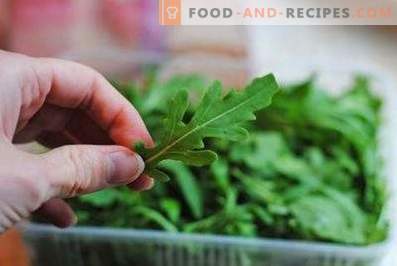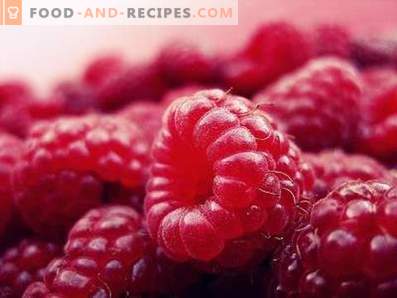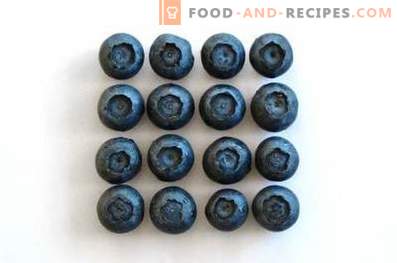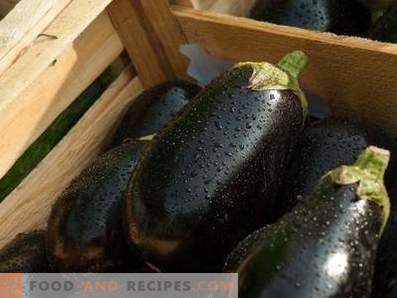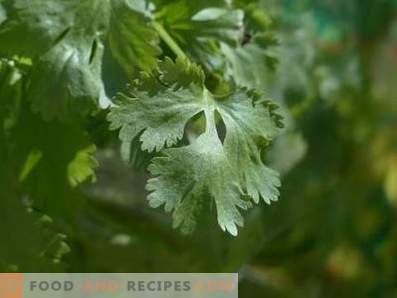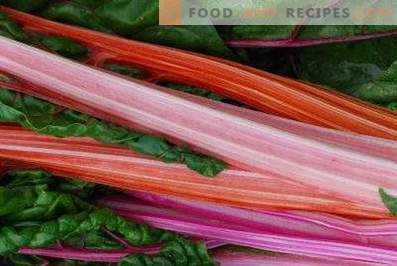
Rhubarb is a herbaceous plant, one of the representatives of the buckwheat family. The homeland of this vegetable is the mountain ranges and forests of Central China. The results of archaeological excavations carried out in the PRC prove that Chinese physicians began to use rhubarb for medical purposes 2700 years ago. On the territory of the country you can still find wild species of this culture.
In Western Europe, rhubarb fell in the XI-XII centuries. Initially, Arab merchants were involved in its supply to the European market. However, after the sea route to India was laid, the Portuguese and Dutch began to trade in rhubarb. In the XVII century, the Chinese began to supply this culture to residents of Eastern Europe.
Today, rhubarb is grown in most countries of the world with a temperate climate. Eat young leaves and petioles of the plant. Of them are preparing salads, jams, syrups, compotes, candied fruits, baking stuffing, wines and liqueurs. The rhizomes and the lower part of the stalks of rhubarb are used in cosmetology and traditional medicine.
Botanical description
Rhubarb is a perennial plant with a thick woody root. Hollow straight stem of culture can reach 300 cm in height and 16 cm in girth. Large (up to 70 cm in diameter) heart-shaped or ovoid palmately lobed basal leaves of the plant sit on elongated cylindrical or multifaceted petioles. Stem leaf plates are smaller.
June rhubarb blossoms in small white, greenish, pink or red flowers, collected in large paniculate inflorescence at the top of the stem. The fruit of the plant is a triangular nutlet of red-brown or brown color. Seeds of culture ripen by early August.
Nutritional Value
100 g of raw rhubarb contains:
- 0, 874 g of proteins;
- 0, 197 g of fat;
- 4, 538 g of carbohydrates;
- 1, 714 g of dietary fiber;
- 93, 609 g of water;
- 0, 751 g of ash;
- 1, 064 g of sugars (mono- and disaccharides);
- 0, 096 g of omega-6 fatty acids.
The concentration of organic acids in the composition of this vegetable is 1, 053 g per 100 g.
Vitamins in rhubarb
Rhubarb is a rich source of vitamins. Every 100 g of this product contains:
- retinol equivalent, A - 4, 898 mkg;
- beta-carotene - 0, 059 mg;
- lutein and zeaxanthin - 169, 015 mkg;
- thiamine, B1 - 0, 018 mg;
- ascorbic acid, C - 7, 883 mg;
- riboflavin, B2 - 0, 024 mg;
- choline, B4 - 6, 092 mg;
- tocopherol equivalent, E - 0, 268 mg;
- pantothenic acid, B5 - 0, 083 mg;
- pyridoxine, B6 - 0, 023 mg;
- Niacin equivalent, PP - 0, 288 mg;
- folic acid, B9 - 6, 689 mkg.
In addition, phylloquinone (vitamin K) is present in rhubarb. The content of this compound is 29, 291 μg per 100 g of product.
Useful items
Trace elements in 100 g of rhubarb:
- zinc - 0, 095 mg;
- copper - 20, 066 mkg;
- iron - 0, 214 mg;
- selenium - 1, 078 mcg;
- manganese - 0, 191 mg.
Macroelements per 100 g of product:
- phosphorus - 13, 487 mg;
- potassium - 287, 053 mg;
- magnesium - 11, 642 mg;
- sodium - 3, 977 mg;
- calcium - 85, 712 mg.
Caloric content of rhubarb
100 g of fresh rhubarb contains 13, 966 kcal. In the same portion of jam from this vegetable - 267, 314 kcal, compote - 27, 809 kcal, jelly - 48, 422 kcal, syrup - 168, 136 kcal. The energy value of candied rhubarb - 288, 431 kcal per 100 g
Benefits of Stems and Rhubarb Leaves
- Compounds present in rhubarb, stimulate the production of digestive enzymes and increase appetite.
- Regular consumption of rhubarb helps avoid vitamin deficiency.
- Dishes from this vegetable contain substances that positively affect the functioning of the kidneys.
- In the juice of rhubarb there are compounds that increase the digestibility of a number of vitamins, micro-and macronutrients.
- The substances contained in this product increase the body's resistance to infections, increase local immunity.
- In alternative medicine, parasitic invasions are treated with rhubarb. People who have been identified parasites, it is recommended to eat daily up to 100 grams of vegetables.
- Dishes from rhubarb stalks are useful for people suffering from chronic constipation.
- The ground part of the plant is rich in compounds that strengthen the heart muscle, increase the strength and elasticity of the venous walls, and regulate the rhythm of the heartbeat. Therefore, regular consumption of this vegetable helps reduce the risk of heart disease.
- Rhubarb is useful in diseases of the gastrointestinal tract that have developed against the background of a decrease in gastric acidity.
- The substances contained in the sap of the plant accelerate the excretion of toxins, slags, radionuclides, salts of heavy metals and other harmful compounds.
- Dishes from rhubarb help eliminate the putrefactive processes in the intestines.
- Rhubarb juice is used to whiten age spots on the skin. A wadded disk soaked with liquid daily wipe problem areas.
- In Tibetan medicine, a decoction or juice of rhubarb treats severe poisonings, bites of poisonous insects and snakes.
- Dishes from this vegetable activate the blood formation system. Therefore, they are useful for people suffering from anemia.
- In folk medicine, rhubarb juice is used as a choleretic agent.
- Drinks with the addition of this vegetable increase the overall tone of the body, help to cope with the breakdown of strength, increase physical endurance and efficiency. They are often recommended for those recovering from serious illnesses.
- Vitamins of group B and other useful nutrients entering the body when eating rhubarb, prevent the occurrence of failures in the central nervous system, help improve sleep, avoid depression, reduce the negative impact of stress on the internal organs and systems.
- Useful compounds that are part of rhubarb, accelerate metabolism. Therefore, the stems and leaves of this plant are often included in the composition of herbal slimming.
- Vitamin A and other nutrients present in the composition of the product, increase visual acuity, help protect the visual apparatus from the effects of adverse factors.
- Rhubarb juice contains substances with anti-inflammatory and regenerating properties. Therefore, in folk medicine it is used for the treatment of nonhealing wounds, as well as the affected areas in trophic ulcers and eczema.
- Chrysarobins are present in the aerial parts of rhubarb - a compound that effectively copes with manifestations of psoriasis. Therefore, patients are advised to daily apply cold compresses from the ground into the gruel of the plant stalks to the problem areas.
- Pectins contained in rhubarb reduce the concentration of “harmful” cholesterol in the blood. Therefore, this vegetable is useful for people suffering from atherosclerosis.
- Rhubarb is a rich source of antioxidants. People who regularly include meals based on it in their ration can slow down the processes causing aging of the body and reduce the likelihood of developing cancer.
- In alternative medicine, rhubarb is used to fight acne, vitiligo, boils, and acne. Problem areas are wiped twice with a mashed plant stem.
- Juice obtained from rhubarb helps get rid of hangover. The liquid (40 ml) is dissolved with water (180 ml) and drunk in one gulp immediately after waking up.
Useful properties of rhubarb roots
- Powder from dried rhubarb roots is used as an astringent in diarrhea. The drug is taken orally for 1/2 teaspoon before breakfast and lunch. The drug is washed down with plenty of water. Sometimes for the treatment of disorders of the stool use alcohol tincture of rhubarb roots. For its preparation, a small handful of crushed vegetable raw materials is poured with a bottle of vodka and insisted in the dark for 14-15 days. The finished tincture is filtered and put in the fridge. With diarrhea, the drug is taken three times a day, 1 tsp.
- Extract obtained from the rhizome of a plant helps to get rid of bloating and flatulence.
- A decoction made from rhubarb roots helps to increase the gastrointestinal motility. Therefore, they drink it instead of tea with intestinal atony.
- In folk medicine, a mixture of dandelion roots, celandine and rhubarb is used to treat congestion in the gallbladder. Half a cup of crushed vegetable raw materials is poured over with 2 cups of boiling water, boiled for 2-3 minutes and infused for at least 3 hours. Ready to drink tea 2 sips before each meal.
- Rhubarb roots are used to treat alopecia (pathological hair loss). From herbal raw materials, a rich decoction is prepared and rinsed with a head every time after washing.
- Rhizomes of plants are used in the complex treatment of hepatitis. A large handful of medicinal raw materials are boiled in a liter of water for 20 minutes and infused for at least 10 hours. The resulting liquid is filtered and take 1 big gulp before breakfast and dinner, seizing a small amount of bee honey. Treatment continued for a month.
- A healing drink is prepared from rhubarb roots, which alleviates the symptoms of tuberculosis. Raw materials (2-3 tbsp. Spoons) are poured with ice-cold water, infused for 8 hours, then brought to a boil over low heat and cooked for 4 minutes. Ready broth is filtered and taken 75 ml three times a day.
- A saturated decoction of the roots of a plant is washed with nonhealing burn wounds.
Contraindications and harm to rhubarb
- Pediatricians do not recommend rhubarb for children under the age of 10 years.
- Vegetable contains a large amount of organic acids, which contribute to the appearance of calculus in the kidneys, gall and bladder. Therefore, it is contraindicated in people who have previously been diagnosed with urolithiasis or cholelithiasis.
- Dishes from rhubarb are harmful to people suffering from pancreatitis or gastritis, which arose against the background of increased acidity of gastric juice.
- Compounds present in rhubarb can thin the blood. Therefore, this vegetable is contraindicated in hemorrhoids and bleeding of various etiologies.
- Nutritionists do not recommend eating rhubarb stalks in large quantities for diarrhea, cholecystitis, gout, peritonitis, cystitis, appendicitis, rheumatism and diabetes.
- Dishes from this vegetable are harmful to pregnant women and mothers who are breastfeeding.
- Rhubarb is contraindicated for people suffering from intestinal restraint or obstruction.
- The leaves of some types of rhubarb can be poisonous.



